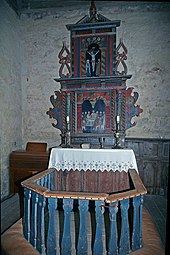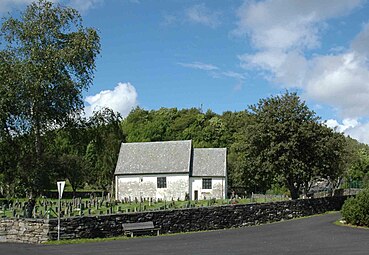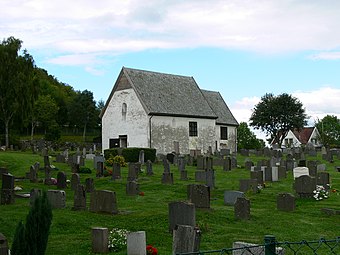Old Moster Church
| Old Moster Church | |
|---|---|
| Moster gamle kyrkje | |
Sunnhordland prosti | |
| Parish | Moster |
| Type | Church |
| Status | Automatically protected |
| ID | 84979 |
Old Moster Church (
History
The Old Moster Church has a long and important history in Norway. According to tradition and the historian
During the 12th century, the old church was torn down and a new stone church was built on the same site. The wall openings have
In 1814, this church served as an election church (Norwegian: valgkirke).[7][8] Together with more than 300 other parish churches across Norway, it was a polling station for elections to the 1814 Norwegian Constituent Assembly which wrote the Constitution of Norway. This was Norway's first national elections. Each church parish was a constituency that elected people called "electors" who later met together in each county to elect the representatives for the assembly that was to meet in Eidsvoll later that year.[7][9]
The old church only seated about 80 people, so by the mid-19th century, the church had become too small for the congregation, so a new
Design
The church has a square, 5.9-by-6-metre (19 ft × 20 ft) choir and a rectangular, 12.4-by-8.1-metre (41 ft × 27 ft) nave and with an entrance in the western wall of the nave and one in the southern wall of the choir. The roof structures were replaced in the 18th century. The church is mainly built of soapstone from a quarry near the village of Lykling.[3][4][6]
Media gallery
-
Altarpiece
-
Interior
-
Interior
-
Exterior
-
Exterior
-
Exterior (from 1926)
-
Exterior
See also
References
- ^ "Moster gamle kyrkje". Kirkesøk: Kirkebyggdatabasen. Retrieved 27 May 2020.
- ^ "Oversikt over Nåværende Kirker" (in Norwegian). KirkeKonsulenten.no. Retrieved 27 May 2020.
- ^ a b c d "Moster gamle kyrkjestad" (in Norwegian). Norwegian Directorate for Cultural Heritage. Retrieved 27 May 2020.
- ^ a b c d "Moster gamle kirke". Norges-Kirker.no (in Norwegian). Retrieved 15 November 2021.
- ^ "Moster gamle kyrkje" (in Norwegian). Bømlo kyrkjelege fellesråd. Retrieved 24 February 2015.
- ^ a b c Lidén, Hans-Emil. "Moster gamle kirke" (in Norwegian). Norges Kirker. Retrieved 15 November 2021.
- ^ a b "Valgkirkene". LokalHistorieWiki.no (in Norwegian). Retrieved 15 November 2021.
- ^ "Valgkartet". Valgene i 1814 (in Norwegian). Arkivverket. Archived from the original on 24 June 2021. Retrieved 15 November 2021.
- ^ "Om valgene". Valgene i 1814 (in Norwegian). Arkivverket. Retrieved 15 November 2021.









